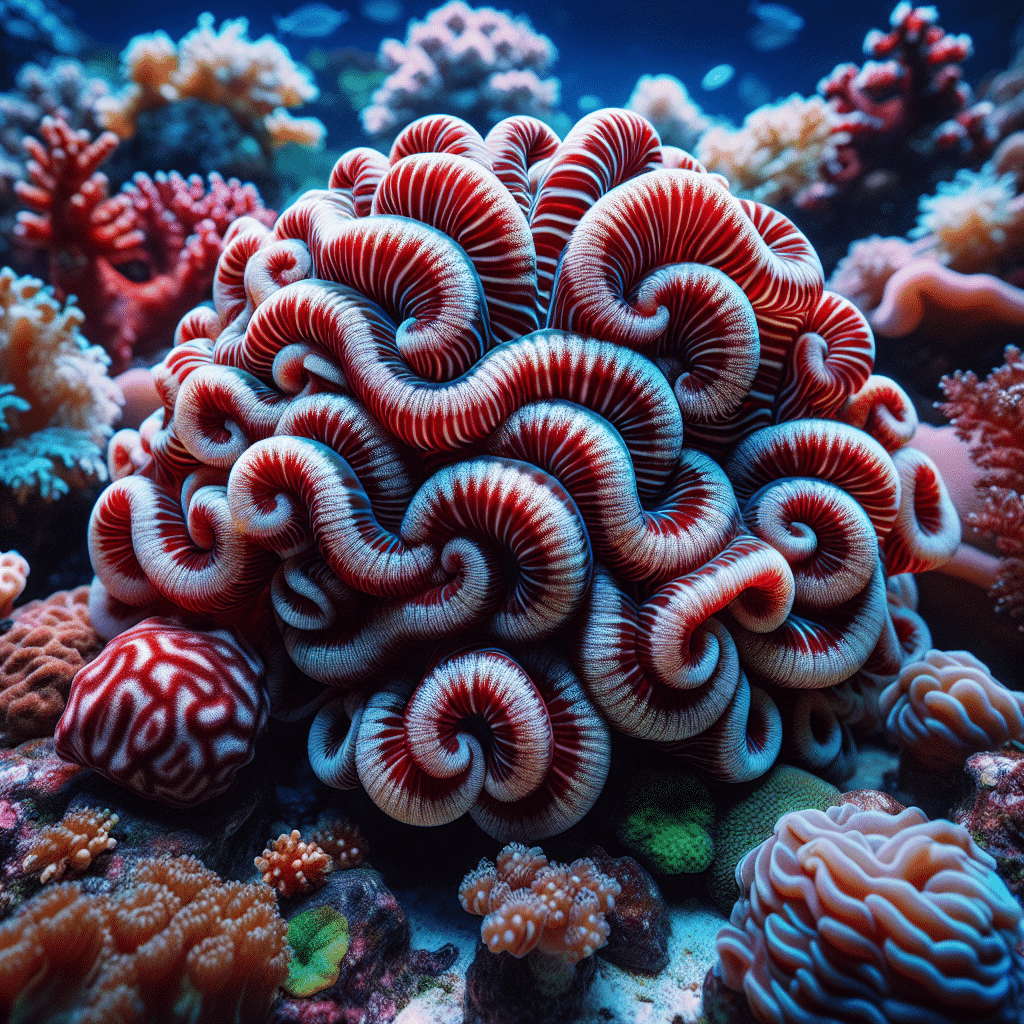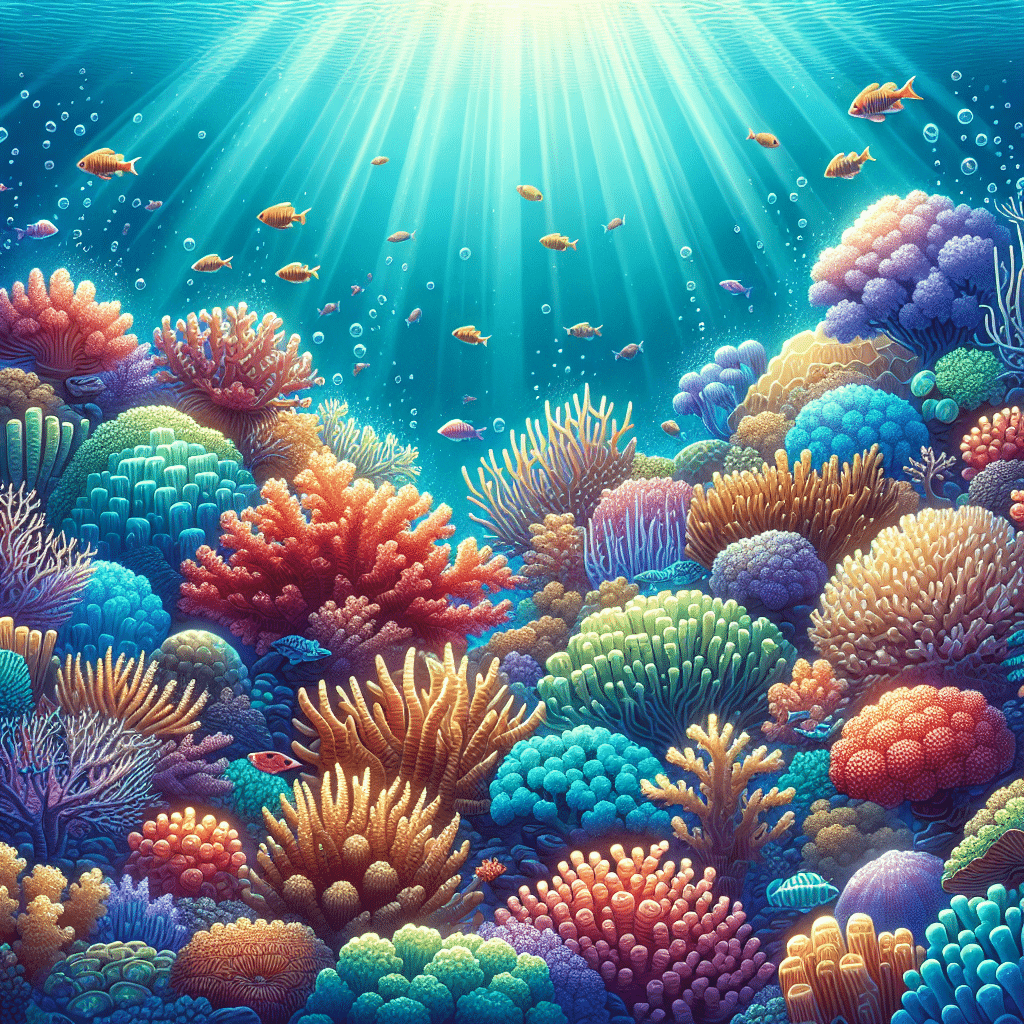Understanding Candy Cane Corals
Introduction to Candy Cane Corals
I’ve always found Candy Cane Corals, also known as Trumpet Corals, to be a fascinating addition to any reef tank. These corals belong to the Caulastrea genus and are classified as large polyp stony (LPS) corals. They are popular among hobbyists for a variety of reasons, including their affordability, ease of care, and the beautiful circular-shaped polyps that come in a range of colors. I’ve read that these corals can be found in the Indo-Pacific region, thriving in shallow reef slopes and sandy substrates, with the potential to form large colonies up to 16 feet across (Light Fish).
Characteristics and Varieties
Candy Cane Corals come in various color morphs, adding a vibrant touch to any aquarium. The Neon Green variety is the most common and affordable, typically priced between $10-30 for a ¾”-sized coral. More unique color morphs, such as Purple and Blue, are rarer and can cost between $25-50 and $30-50, respectively (Light Fish).
These corals are considered beginner-friendly due to their hardiness and low aggression levels. I’ve noticed that they adapt well to different lighting conditions and are forgiving of slight fluctuations in calcium and alkalinity levels, making them easier to care for compared to other LPS corals (Tidal Gardens).
Here’s a quick reference table summarizing the characteristics and varieties of Candy Cane Corals:
| Color Morph | Price Range | Size |
|---|---|---|
| Neon Green | $10 – $30 | ¾” |
| Purple | $25 – $50 | ¾” |
| Blue | $30 – $50 | ¾” |
With their striking appearance and manageable care requirements, Candy Cane Corals make an appealing choice for both new and experienced reef tank enthusiasts. If you’re considering adding some corals to your tank, these could be a perfect option. For more information about other coral types, check out our articles on brain coral, torch coral, and zoanthids.
Care Guide for Candy Cane Corals
Taking care of candy cane corals can be a rewarding experience for any reef tank hobbyist. Here’s a comprehensive guide to ensure these beautiful corals thrive in your aquarium.
Tank Size and Environment
I’ve found that candy cane corals can be kept in an aquarium of at least 75 gallons, although they can adapt to smaller tanks. The key is to maintain stable water parameters and provide the right environment for their growth. These corals prefer a space with moderate water flow and enough room to expand, as they can grow large over time.
Water Quality and Parameters
Maintaining the right water quality is crucial for the health of candy cane corals. Here are some important parameters to monitor:
| Parameter | Ideal Range |
|---|---|
| Temperature | 72°F – 78°F |
| pH | 8.1 – 8.4 |
| Salinity | 1.023 – 1.025 |
| Calcium | 400 – 450 ppm |
| Alkalinity | 8 – 12 dKH |
| Magnesium | 1250 – 1350 ppm |
Calcium and alkalinity levels are particularly important because candy cane corals are stony corals. They rely on these elements to form their calcium carbonate skeleton (Tidal Gardens). Regular testing and adjustments can help keep these parameters in check.
Lighting and Placement
When it comes to lighting, candy cane corals do not require intense illumination. I’ve noticed that they thrive under a variety of lighting conditions, with a range of 50 to 70 PAR being adequate for their health and color. Overexposure can be detrimental, so placing them in a spot with moderate light is ideal.
I recommend positioning them away from bright direct light but ensuring they still receive enough to promote healthy growth. For more information on various types of corals and their lighting needs, check out our article on corals.
Feeding and Nutrition
Feeding candy cane corals isn’t strictly necessary, but it can significantly enhance their growth. I usually spot feed them 2-3 times a week with foods like frozen mysis shrimp, krill, or LPS pellets. Spot feeding involves turning off the pumps to allow food to settle on the polyps, but I always keep an eye out to prevent fish from stealing the food (Tidal Gardens).
Although they can capture tiny bits of food floating around, regular feeding tends to improve their health. They also benefit from zooxanthellae, symbiotic algae that provide nutrients through photosynthesis. For more tips on feeding methods, feel free to explore our article on feeding corals.
By following these guidelines, I’ve found that candy cane corals can flourish in my reef tank, adding beauty and diversity to the ecosystem.
Growth and Reproduction of Candy Cane Corals
Growth Rate and Propagation
Candy Cane Corals are known for their impressive growth rate, thriving under the right conditions. They can grow up to ¼ inch per month, and with proper care, they can increase from just one polyp to twenty within a year. This rapid propagation is achievable when the corals are kept in a pristine environment and are fed directly twice a week (Light Fish).
Their growth can be summarized in the following table:
| Growth Metric | Rate |
|---|---|
| Monthly Growth | Up to ¼ inch |
| Polyp Expansion | 1 to 20 in a year with proper care |
Candy Cane Corals are among the easiest LPS (large polyp stony) corals to care for, making them a suitable choice for beginners in reef keeping. They tolerate slight increases in nitrates, which can often be beneficial in a diverse reef tank environment (Light Fish).
Fragging Techniques
As these corals grow, they may outgrow their designated space in the aquarium. Fortunately, fragging Candy Cane Corals is a straightforward process. Fragging involves cutting through the stalk of the coral and then securely gluing the resulting frag onto a rock or frag plug. This method allows for the coral to be relocated to another tank or even sold, providing an opportunity to propagate more of these vibrant creatures (FantaSEA Aquariums).
Here’s a quick overview of the fragging process:
- Select a Healthy Coral: Ensure the coral is in good health before fragging.
- Prepare Tools: Use sharp, clean scissors or a knife to make a clean cut.
- Make the Cut: Carefully cut through the stalk, ensuring you leave some tissue on the frag.
- Attach the Frag: Use aquarium-safe glue to attach the frag to a rock or plug.
- Acclimate: Allow the frag to acclimate in the tank for a few days before moving it to a permanent spot.
With proper care and fragging techniques, I find that Candy Cane Corals can provide both aesthetic value and a rewarding experience in reef tank maintenance. If you’re interested in exploring other coral options, check out our articles on brain coral and torch coral for more insights.
Common Issues and Diseases
Common Problems in Candy Cane Corals
As a hobbyist, I’ve encountered a few common issues with Candy Cane Corals that can affect their health and growth. Here are some of the most frequent problems:
| Problem | Description |
|---|---|
| Bleaching | This occurs when corals lose their color, often due to stress from poor water quality or excessive light exposure. |
| Flesh Loss | If the coral’s polyps start to recede or lose flesh, it may be due to high water flow or inadequate feeding. |
| Stinging | Candy Cane Corals have stinging tentacles that can harm neighboring corals if placed too close together. |
| Nutrient Deficiency | Lack of proper nutrition can lead to stunted growth and poor coloration. Regular spot feeding can help mitigate this issue. |
Candy Cane Corals are generally hardy and suitable for beginners, but they can still be sensitive to their environment. Maintaining stable water parameters is essential for preventing these issues. For more information on their care, check out the section on care guide for candy cane corals.
Preventative Measures
To keep my Candy Cane Corals thriving and minimize potential problems, I follow a few preventative measures:
Stable Water Parameters: Regularly test water quality to ensure parameters like salinity, pH, and nitrates are within acceptable ranges. Candy Cane Corals can tolerate subtle increases in nitrates, but it’s best to keep levels low.
Lighting Control: Since these corals don’t require intense lighting, I maintain a light intensity of 50 to 70 PAR. Monitoring light exposure helps prevent bleaching.
Flow Management: I place my Candy Cane Corals in low flow areas of the tank to avoid flesh loss. Excessive flow can stress the corals and lead to health issues.
Spot Feeding: Although not mandatory, I spot feed my corals 2-3 times a week with frozen mysis shrimp or LPS pellets. This supports their growth and health.
Tank Placement: Keeping a safe distance from other corals prevents stinging and allows for better growth. I also ensure there’s enough space for the polyps to expand.
By implementing these measures, I’ve seen my Candy Cane Corals flourish and maintain their vibrant colors. For more coral care tips, check out my articles on various coral types such as brain coral, mushroom coral, and torch coral.
Benefits of Candy Cane Corals
Ecosystem Contributions
Candy cane corals, also known as Caulastrea furcata, play a significant role in the health of marine ecosystems. These corals belong to the LPS (large polyp stony) category and can be found in the Indo-Pacific region, contributing to the biodiversity of reef systems. Coral reefs, despite covering less than one percent of the ocean floor, support about 25 percent of all marine creatures (National Geographic).
The presence of candy cane corals helps to provide habitat and shelter for various marine species, promoting a balanced ecosystem. Their ability to tolerate fluctuations in water quality, such as slight increases in nitrates, makes them a suitable choice for reef tank hobbyists, especially those who are just starting out. This hardiness contributes to the stability of the reef and encourages a diverse array of life forms.
Aesthetics and Aquarium Health
In addition to their ecological benefits, candy cane corals are a fantastic addition to any reef tank due to their stunning appearance. Their vibrant colors and unique structure can enhance the visual appeal of an aquarium, making them a popular choice among fish tank enthusiasts. The hardy nature of candy cane corals means they can thrive under various lighting conditions, maintaining their beauty without the need for excessive care.
Candy cane corals also contribute to the overall health of the aquarium by helping to stabilize water parameters. They are forgiving of slight fluctuations in calcium and alkalinity levels, making them easier to care for compared to other coral species. This resilience allows them to thrive even in less-than-perfect conditions, which is beneficial for both novice and experienced reef keepers. For those interested in learning more about different types of corals that can complement candy cane corals in a tank, check out our articles on brain coral, mushroom coral, and zoanthids.
In summary, incorporating candy cane corals into a reef tank not only enhances the aquarium’s aesthetic appeal but also supports a healthy and diverse marine ecosystem.



